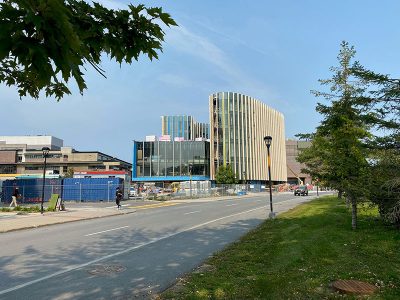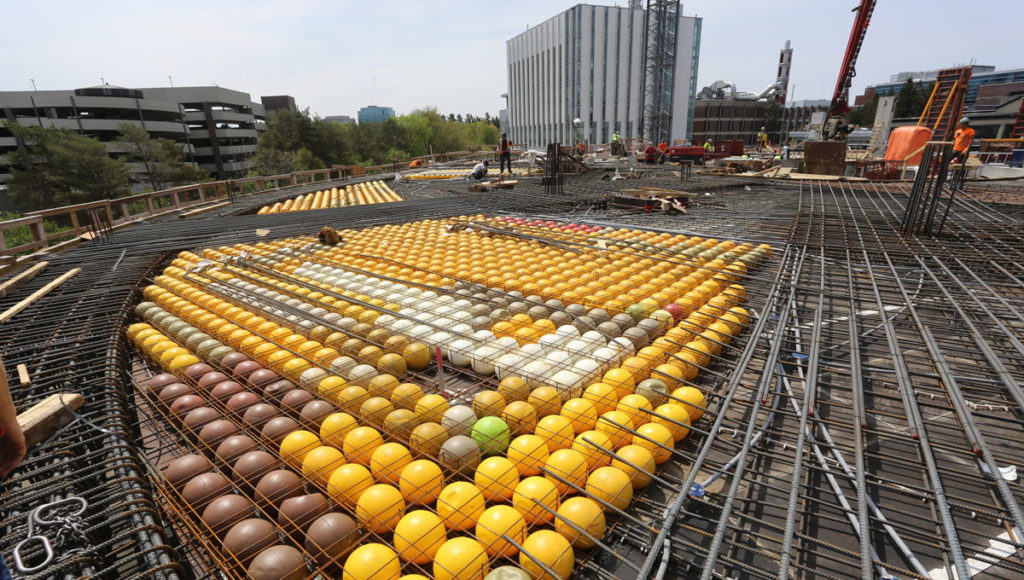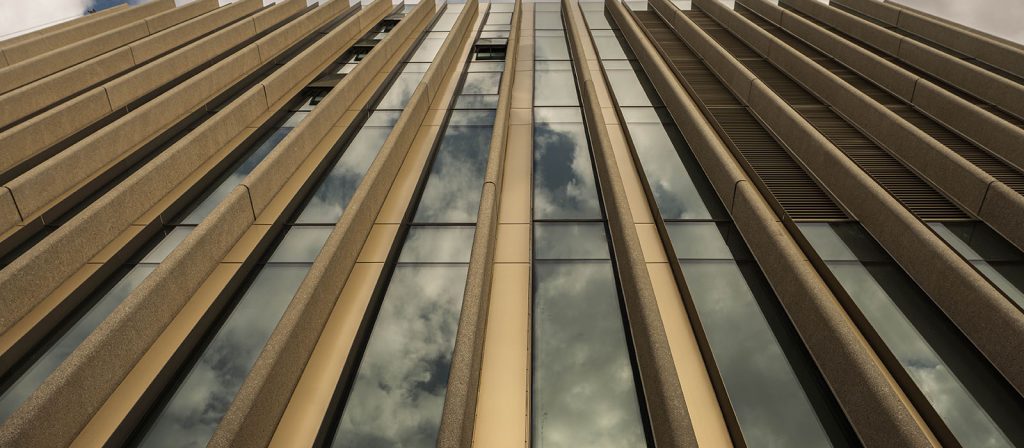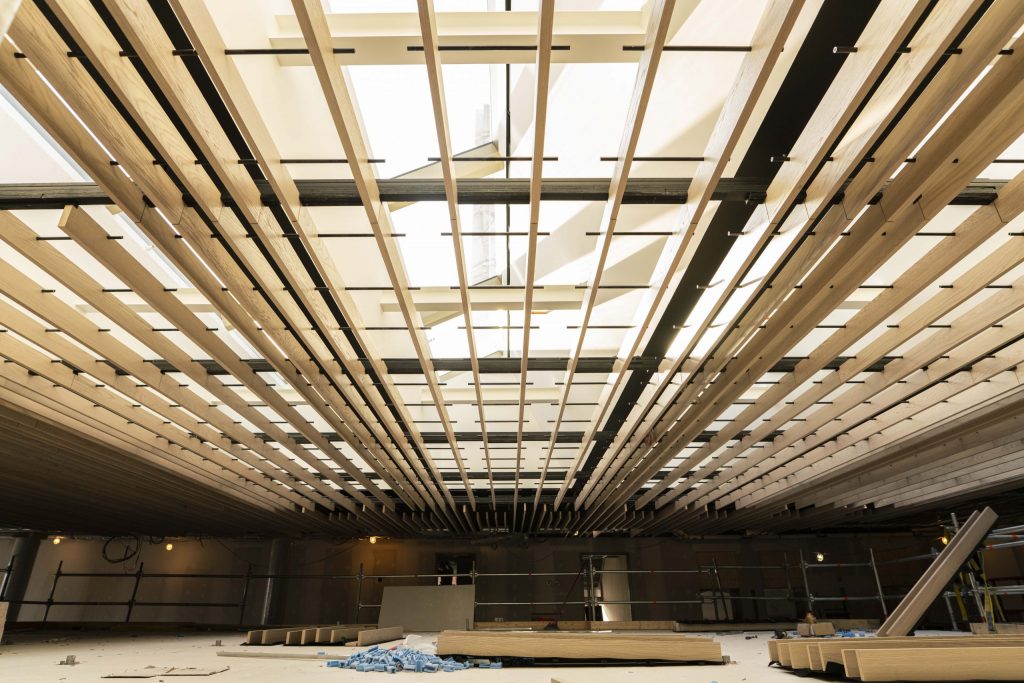Sustainable from Core to Skin: A closer look at the Nicol Building’s green design
Carleton University recently launched its new sustainability plan, while the Sprott School of Business introduced its strategic plan – both emphasizing their commitment towards a responsible future. And the Nicol Building is an embodiment of that promise.

Sustainability has been embedded in every facet of Sprott’s future home. The building is expected to achieve 4.5/5 Green Globes, a nationally recognized environmental building certification.
As the Nicol Building heads towards completion in 2021, we sat down with Doron Meinhard – associate partner at Hariri Pontarini Architects – to learn more about the incorporation of sustainability within.
Sustainable from the ground up
The first challenge the architects faced was the configuration of the design and the choice of materials.
Concrete is one of the most carbon and greenhouse gas intensive building materials, “it has a huge footprint”. However, it’s also an excellent building material due to its stability, fire resistance, acoustic and vibration dampening benefits. Instead of eliminating concrete entirely, Doron explained, Hariri Pontarini set out to make the Nicol Building as light as they possibly could to reduce the amount of concrete needed.
They divided their design into two portions: the first few floors which would hold many people in large spaces – such as classrooms and gathering places – hence requiring a deep floor plate; and the top floors which would house offices with fewer residents, requiring a shallow floorplate with more access to daylight.
“The challenge was to create a building that had a very broad base and narrowed to a slender top.”
This design significantly reduced the amount of concrete required; and they reduced it further by using BubbleDeck technology in the first four floors.

In a concrete slab, the top and bottom do most of the work, while the middle does very little. So, the BubbleDeck replaces the concrete within the slab with 10-inch hollow balls of recycled plastic around which concrete is poured.
The Nicol Building is the first institutional building in Ottawa to use this technology. A total of 11,300 bubbles were used, which displaced nearly 163 tonnes of concrete or equivalent to 100 kg of concrete per every kilogram of recycled plastic.
As the architects designed the upper floors of the building, they switched from concrete to structural steel to make it lighter still.
“Through these methods we were able to reduce concrete mass by about 27 per cent,” Doron said. Consolidating the building’s weight near the bottom also made it much more efficient to reduce seismic forces.
Responsible systems at work
Then there were mechanical and electrical considerations.
“Carleton pays a lot of attention to energy consumption and likes to find robust solutions.”
One of the first things the architects did to conserve energy in the building was place the fan room in the basement, instead of the top floor where it is usually located. Since the bulk of the Nicol Building’s population will be on the first three floors, this way the air is closer to where it needs to go the most.
Next, they separated ventilation and heating systems, since combining these two necessities in a building is not energy efficient.
The heating system – which uses steam and hot water instead of forced-air ventilation – focuses mostly on the perimeter envelope because that is where heat is needed the most to effectively and efficiently heat the building.
For the ventilation system, all the components are outfitted with heat and energy recovery wheels. Buildings need a certain amount of fresh air coming in, which in the winter needs to be heated up and requires extremely high energy usage. However, these energy wheels allow the ventilation system to take the heat and moisture from the exhaust air and supply it to the cold fresh air coming in – resulting in a significant reduction in energy consumption.
Furthermore, the ventilation is demand-controlled. All rooms in the building have sensors which measure carbon dioxide to determine how many people are in the room, then in turn ventilate the room accordingly. The thermostats and lights are equipped with occupancy sensors. So, if a room is empty, the thermostat will drop the room temperature down to 18°C and lights will be turned off.
Visual design features
Hariri Pontarini took special considerations for the exterior to support the systems within the building without compromising its visual design.
They created a unified system of vertical concrete fins, which provide a solid wall between each glass pane, to further insulate the building and prevent direct glare from the sun coming in. This helps keep the heating and cooling costs down in summer and winter, while creating “architectural depth”.

Inside, concrete has been left exposed on the floors, thus eliminating additional flooring materials such as porcelain or vinyl. This aesthetic has been enhanced by a variety of natural materials used throughout the building, such as locally sourced stone and oak.
Connecting with nature
One of the most important considerations was the landscape surrounding the building.
“The landscape experience is really important when you’re inside a building,” Doron added. “Trying to give people a sense that they’re connected to nature increases well-being.”
“We look at sustainability holistically. It’s not just about saving energy, reducing your carbon footprint. It’s also about wellness. Feeling good. Having a connection to daylight and nature.”
Keeping this in mind they designed the rhythm of graceful windows to embrace the south courtyard and Carleton’s future entry quad, which will become an extension of the building. Also, the elevation on Campus Avenue is lined with a very deep and long landscape planter turning it into a green boulevard. Furthermore, the building also features a large central skylight to bring sun into the hive; and another skylight on the ground outside, to bring natural light into the tunnel junction.

“Carleton and Sprott know that sustainability is one of the key challenges facing us. And their position from the start was to incorporate it here in a robust and measured way. This was not about gimmicks, they cared about the actual benefits.”
Doron believes that all these factors will combine to make the Nicol Building one which everyone at Carleton University will be proud of in the future.
Learn more about the Nicol Building and the architect’s vision behind the design.